NUR2203: Nursing the Surgical Patient - Knee Replacement Essay
VerifiedAdded on 2022/10/04
|10
|2934
|37
Essay
AI Summary
This essay focuses on the post-operative nursing care of a 76-year-old male, Frank Wright, who underwent a right total knee replacement. It details the post-surgical plan, including immediate care, mobilization, DVT prophylaxis, pain management, and monitoring of vital signs. The essay explores the impact of co-morbidities like hypertension, diabetes, and OSA, along with the effects of general anesthesia on recovery. It also covers the importance of pre-habilitation, resistance training, and psychological interventions. Finally, the essay outlines the discharge planning process, emphasizing the patient's ability to walk independently, the use of ambulatory aids, physical therapy, and precautions to take. The essay highlights the nurse's role in monitoring, implementing interventions, and ensuring a smooth recovery, while also emphasizing the need for the patient to avoid smoking and follow a healthy lifestyle. This assignment is a good example of the quality of work available on Desklib.
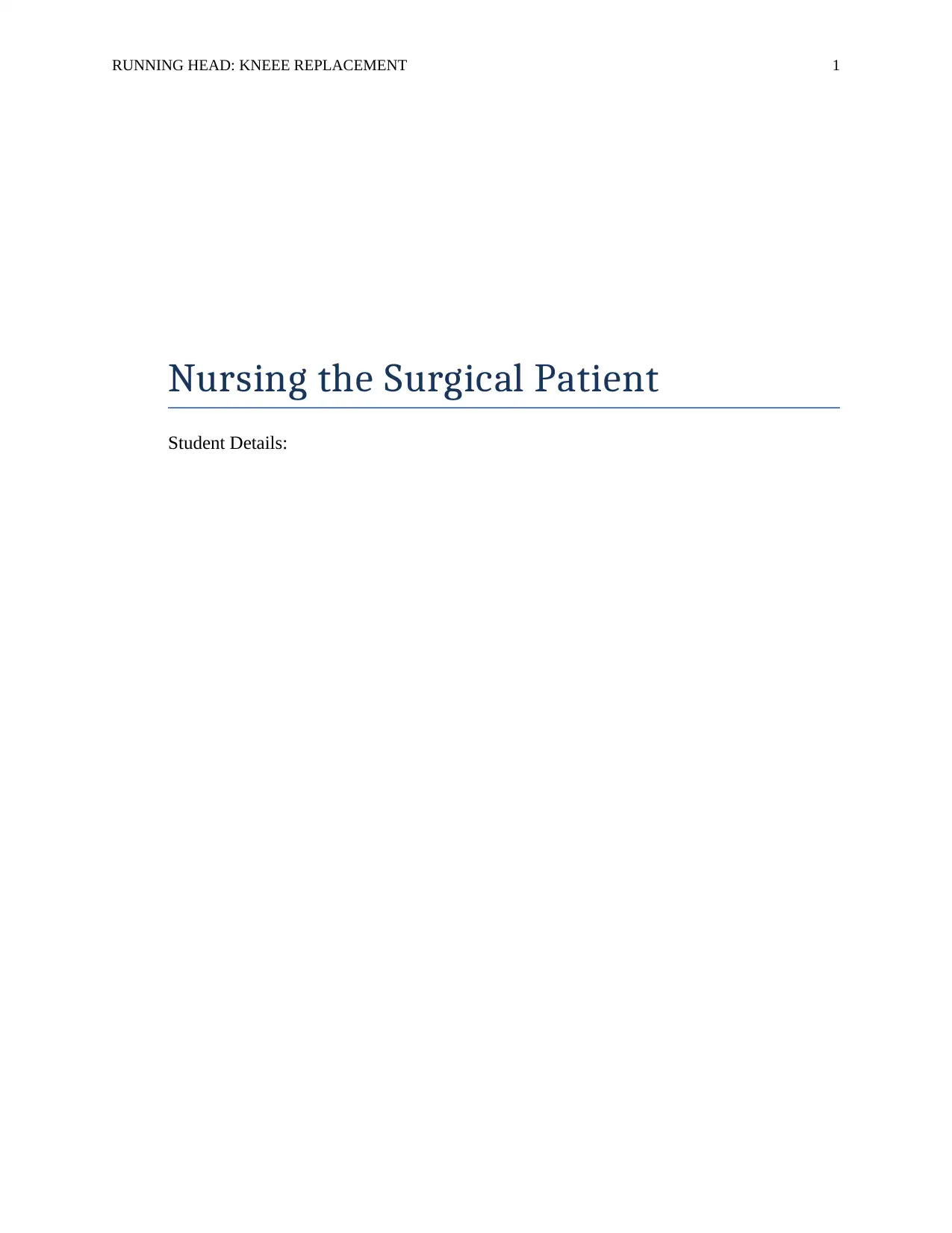
RUNNING HEAD: KNEEE REPLACEMENT 1
Nursing the Surgical Patient
Student Details:
Nursing the Surgical Patient
Student Details:
Paraphrase This Document
Need a fresh take? Get an instant paraphrase of this document with our AI Paraphraser

KNEE REPLACEMENT 2
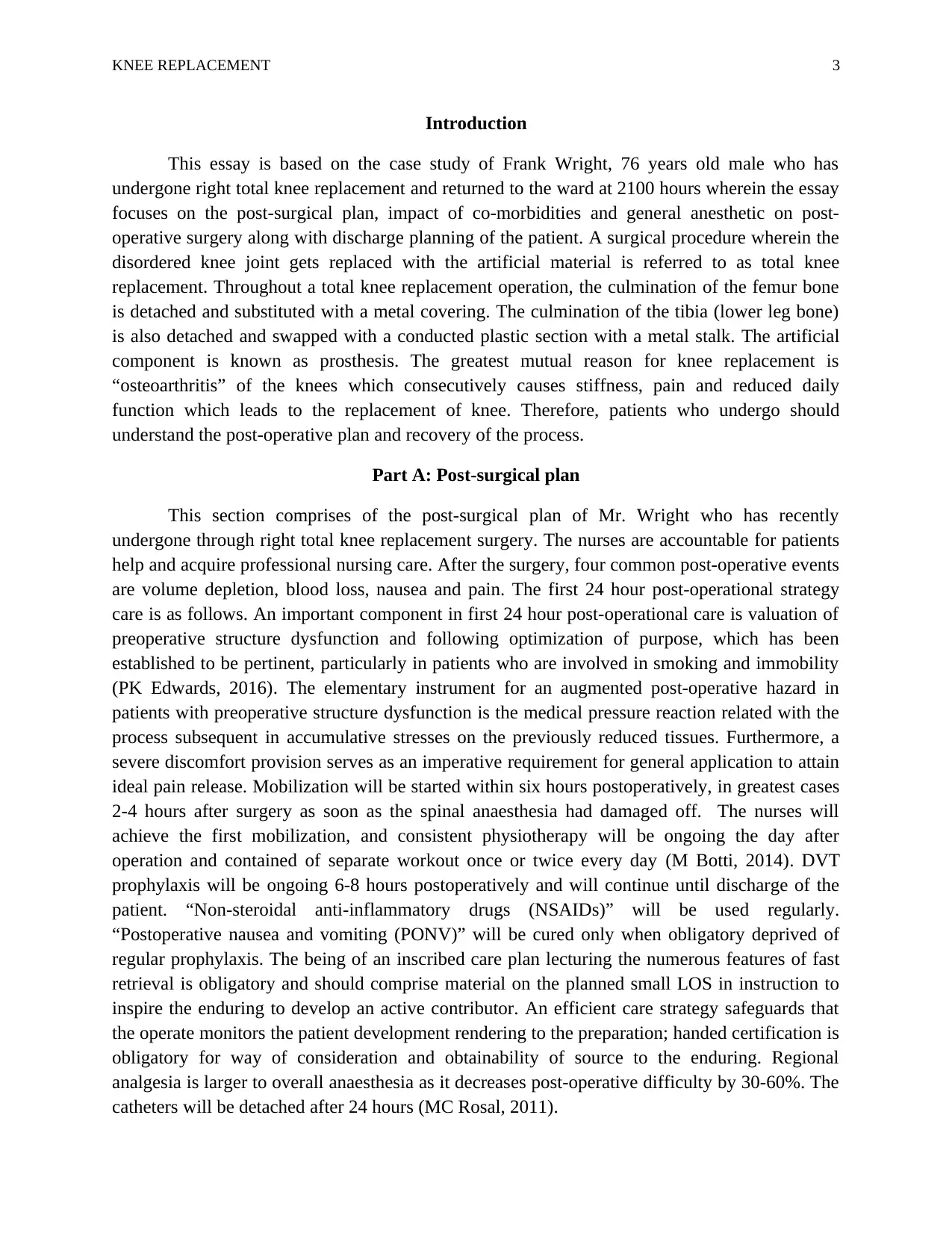
KNEE REPLACEMENT 3
Introduction
This essay is based on the case study of Frank Wright, 76 years old male who has
undergone right total knee replacement and returned to the ward at 2100 hours wherein the essay
focuses on the post-surgical plan, impact of co-morbidities and general anesthetic on post-
operative surgery along with discharge planning of the patient. A surgical procedure wherein the
disordered knee joint gets replaced with the artificial material is referred to as total knee
replacement. Throughout a total knee replacement operation, the culmination of the femur bone
is detached and substituted with a metal covering. The culmination of the tibia (lower leg bone)
is also detached and swapped with a conducted plastic section with a metal stalk. The artificial
component is known as prosthesis. The greatest mutual reason for knee replacement is
“osteoarthritis” of the knees which consecutively causes stiffness, pain and reduced daily
function which leads to the replacement of knee. Therefore, patients who undergo should
understand the post-operative plan and recovery of the process.
Part A: Post-surgical plan
This section comprises of the post-surgical plan of Mr. Wright who has recently
undergone through right total knee replacement surgery. The nurses are accountable for patients
help and acquire professional nursing care. After the surgery, four common post-operative events
are volume depletion, blood loss, nausea and pain. The first 24 hour post-operational strategy
care is as follows. An important component in first 24 hour post-operational care is valuation of
preoperative structure dysfunction and following optimization of purpose, which has been
established to be pertinent, particularly in patients who are involved in smoking and immobility
(PK Edwards, 2016). The elementary instrument for an augmented post-operative hazard in
patients with preoperative structure dysfunction is the medical pressure reaction related with the
process subsequent in accumulative stresses on the previously reduced tissues. Furthermore, a
severe discomfort provision serves as an imperative requirement for general application to attain
ideal pain release. Mobilization will be started within six hours postoperatively, in greatest cases
2-4 hours after surgery as soon as the spinal anaesthesia had damaged off. The nurses will
achieve the first mobilization, and consistent physiotherapy will be ongoing the day after
operation and contained of separate workout once or twice every day (M Botti, 2014). DVT
prophylaxis will be ongoing 6-8 hours postoperatively and will continue until discharge of the
patient. “Non-steroidal anti-inflammatory drugs (NSAIDs)” will be used regularly.
“Postoperative nausea and vomiting (PONV)” will be cured only when obligatory deprived of
regular prophylaxis. The being of an inscribed care plan lecturing the numerous features of fast
retrieval is obligatory and should comprise material on the planned small LOS in instruction to
inspire the enduring to develop an active contributor. An efficient care strategy safeguards that
the operate monitors the patient development rendering to the preparation; handed certification is
obligatory for way of consideration and obtainability of source to the enduring. Regional
analgesia is larger to overall anaesthesia as it decreases post-operative difficulty by 30-60%. The
catheters will be detached after 24 hours (MC Rosal, 2011).
Introduction
This essay is based on the case study of Frank Wright, 76 years old male who has
undergone right total knee replacement and returned to the ward at 2100 hours wherein the essay
focuses on the post-surgical plan, impact of co-morbidities and general anesthetic on post-
operative surgery along with discharge planning of the patient. A surgical procedure wherein the
disordered knee joint gets replaced with the artificial material is referred to as total knee
replacement. Throughout a total knee replacement operation, the culmination of the femur bone
is detached and substituted with a metal covering. The culmination of the tibia (lower leg bone)
is also detached and swapped with a conducted plastic section with a metal stalk. The artificial
component is known as prosthesis. The greatest mutual reason for knee replacement is
“osteoarthritis” of the knees which consecutively causes stiffness, pain and reduced daily
function which leads to the replacement of knee. Therefore, patients who undergo should
understand the post-operative plan and recovery of the process.
Part A: Post-surgical plan
This section comprises of the post-surgical plan of Mr. Wright who has recently
undergone through right total knee replacement surgery. The nurses are accountable for patients
help and acquire professional nursing care. After the surgery, four common post-operative events
are volume depletion, blood loss, nausea and pain. The first 24 hour post-operational strategy
care is as follows. An important component in first 24 hour post-operational care is valuation of
preoperative structure dysfunction and following optimization of purpose, which has been
established to be pertinent, particularly in patients who are involved in smoking and immobility
(PK Edwards, 2016). The elementary instrument for an augmented post-operative hazard in
patients with preoperative structure dysfunction is the medical pressure reaction related with the
process subsequent in accumulative stresses on the previously reduced tissues. Furthermore, a
severe discomfort provision serves as an imperative requirement for general application to attain
ideal pain release. Mobilization will be started within six hours postoperatively, in greatest cases
2-4 hours after surgery as soon as the spinal anaesthesia had damaged off. The nurses will
achieve the first mobilization, and consistent physiotherapy will be ongoing the day after
operation and contained of separate workout once or twice every day (M Botti, 2014). DVT
prophylaxis will be ongoing 6-8 hours postoperatively and will continue until discharge of the
patient. “Non-steroidal anti-inflammatory drugs (NSAIDs)” will be used regularly.
“Postoperative nausea and vomiting (PONV)” will be cured only when obligatory deprived of
regular prophylaxis. The being of an inscribed care plan lecturing the numerous features of fast
retrieval is obligatory and should comprise material on the planned small LOS in instruction to
inspire the enduring to develop an active contributor. An efficient care strategy safeguards that
the operate monitors the patient development rendering to the preparation; handed certification is
obligatory for way of consideration and obtainability of source to the enduring. Regional
analgesia is larger to overall anaesthesia as it decreases post-operative difficulty by 30-60%. The
catheters will be detached after 24 hours (MC Rosal, 2011).
⊘ This is a preview!⊘
Do you want full access?
Subscribe today to unlock all pages.

Trusted by 1+ million students worldwide
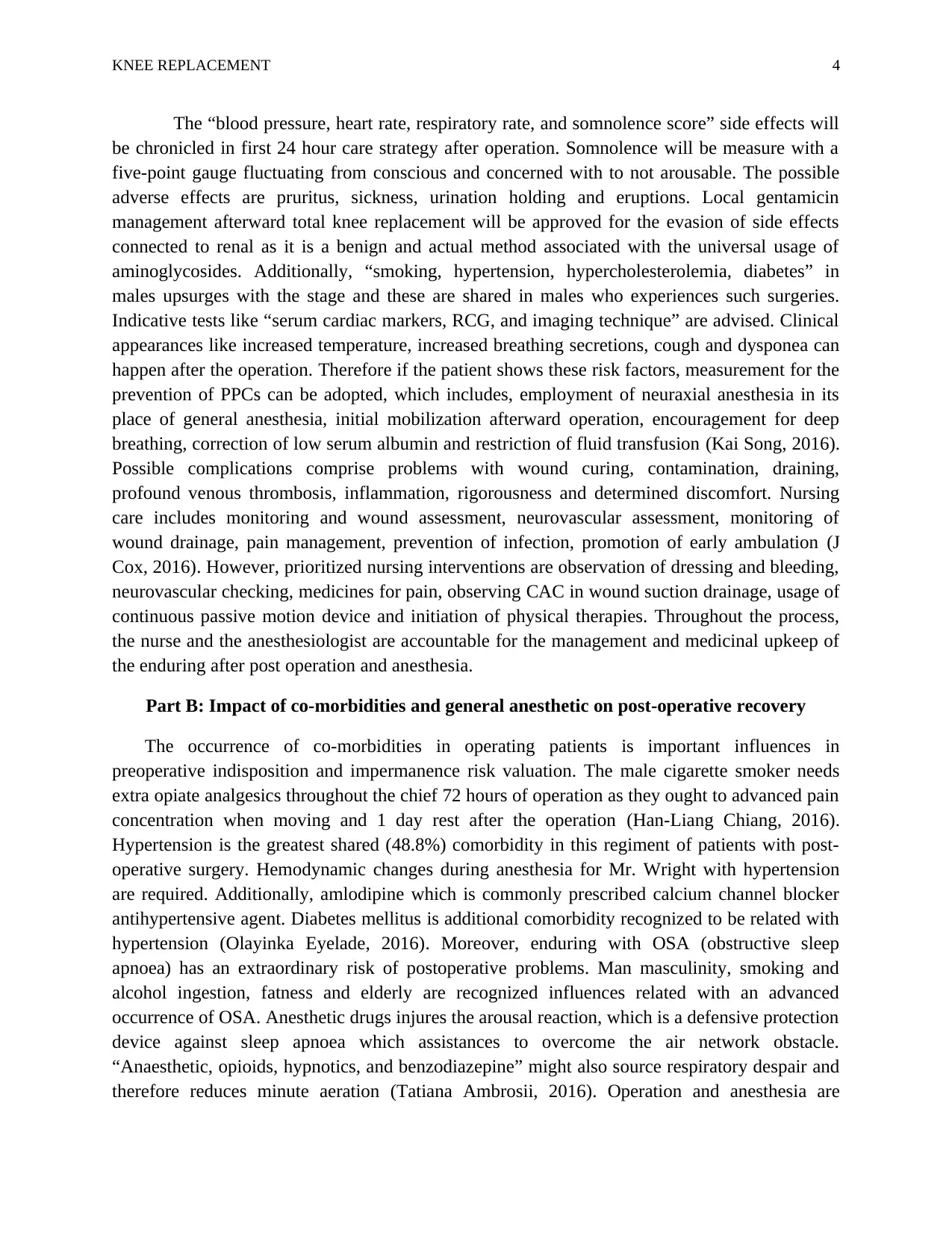
KNEE REPLACEMENT 4
The “blood pressure, heart rate, respiratory rate, and somnolence score” side effects will
be chronicled in first 24 hour care strategy after operation. Somnolence will be measure with a
five-point gauge fluctuating from conscious and concerned with to not arousable. The possible
adverse effects are pruritus, sickness, urination holding and eruptions. Local gentamicin
management afterward total knee replacement will be approved for the evasion of side effects
connected to renal as it is a benign and actual method associated with the universal usage of
aminoglycosides. Additionally, “smoking, hypertension, hypercholesterolemia, diabetes” in
males upsurges with the stage and these are shared in males who experiences such surgeries.
Indicative tests like “serum cardiac markers, RCG, and imaging technique” are advised. Clinical
appearances like increased temperature, increased breathing secretions, cough and dysponea can
happen after the operation. Therefore if the patient shows these risk factors, measurement for the
prevention of PPCs can be adopted, which includes, employment of neuraxial anesthesia in its
place of general anesthesia, initial mobilization afterward operation, encouragement for deep
breathing, correction of low serum albumin and restriction of fluid transfusion (Kai Song, 2016).
Possible complications comprise problems with wound curing, contamination, draining,
profound venous thrombosis, inflammation, rigorousness and determined discomfort. Nursing
care includes monitoring and wound assessment, neurovascular assessment, monitoring of
wound drainage, pain management, prevention of infection, promotion of early ambulation (J
Cox, 2016). However, prioritized nursing interventions are observation of dressing and bleeding,
neurovascular checking, medicines for pain, observing CAC in wound suction drainage, usage of
continuous passive motion device and initiation of physical therapies. Throughout the process,
the nurse and the anesthesiologist are accountable for the management and medicinal upkeep of
the enduring after post operation and anesthesia.
Part B: Impact of co-morbidities and general anesthetic on post-operative recovery
The occurrence of co-morbidities in operating patients is important influences in
preoperative indisposition and impermanence risk valuation. The male cigarette smoker needs
extra opiate analgesics throughout the chief 72 hours of operation as they ought to advanced pain
concentration when moving and 1 day rest after the operation (Han-Liang Chiang, 2016).
Hypertension is the greatest shared (48.8%) comorbidity in this regiment of patients with post-
operative surgery. Hemodynamic changes during anesthesia for Mr. Wright with hypertension
are required. Additionally, amlodipine which is commonly prescribed calcium channel blocker
antihypertensive agent. Diabetes mellitus is additional comorbidity recognized to be related with
hypertension (Olayinka Eyelade, 2016). Moreover, enduring with OSA (obstructive sleep
apnoea) has an extraordinary risk of postoperative problems. Man masculinity, smoking and
alcohol ingestion, fatness and elderly are recognized influences related with an advanced
occurrence of OSA. Anesthetic drugs injures the arousal reaction, which is a defensive protection
device against sleep apnoea which assistances to overcome the air network obstacle.
“Anaesthetic, opioids, hypnotics, and benzodiazepine” might also source respiratory despair and
therefore reduces minute aeration (Tatiana Ambrosii, 2016). Operation and anesthesia are
The “blood pressure, heart rate, respiratory rate, and somnolence score” side effects will
be chronicled in first 24 hour care strategy after operation. Somnolence will be measure with a
five-point gauge fluctuating from conscious and concerned with to not arousable. The possible
adverse effects are pruritus, sickness, urination holding and eruptions. Local gentamicin
management afterward total knee replacement will be approved for the evasion of side effects
connected to renal as it is a benign and actual method associated with the universal usage of
aminoglycosides. Additionally, “smoking, hypertension, hypercholesterolemia, diabetes” in
males upsurges with the stage and these are shared in males who experiences such surgeries.
Indicative tests like “serum cardiac markers, RCG, and imaging technique” are advised. Clinical
appearances like increased temperature, increased breathing secretions, cough and dysponea can
happen after the operation. Therefore if the patient shows these risk factors, measurement for the
prevention of PPCs can be adopted, which includes, employment of neuraxial anesthesia in its
place of general anesthesia, initial mobilization afterward operation, encouragement for deep
breathing, correction of low serum albumin and restriction of fluid transfusion (Kai Song, 2016).
Possible complications comprise problems with wound curing, contamination, draining,
profound venous thrombosis, inflammation, rigorousness and determined discomfort. Nursing
care includes monitoring and wound assessment, neurovascular assessment, monitoring of
wound drainage, pain management, prevention of infection, promotion of early ambulation (J
Cox, 2016). However, prioritized nursing interventions are observation of dressing and bleeding,
neurovascular checking, medicines for pain, observing CAC in wound suction drainage, usage of
continuous passive motion device and initiation of physical therapies. Throughout the process,
the nurse and the anesthesiologist are accountable for the management and medicinal upkeep of
the enduring after post operation and anesthesia.
Part B: Impact of co-morbidities and general anesthetic on post-operative recovery
The occurrence of co-morbidities in operating patients is important influences in
preoperative indisposition and impermanence risk valuation. The male cigarette smoker needs
extra opiate analgesics throughout the chief 72 hours of operation as they ought to advanced pain
concentration when moving and 1 day rest after the operation (Han-Liang Chiang, 2016).
Hypertension is the greatest shared (48.8%) comorbidity in this regiment of patients with post-
operative surgery. Hemodynamic changes during anesthesia for Mr. Wright with hypertension
are required. Additionally, amlodipine which is commonly prescribed calcium channel blocker
antihypertensive agent. Diabetes mellitus is additional comorbidity recognized to be related with
hypertension (Olayinka Eyelade, 2016). Moreover, enduring with OSA (obstructive sleep
apnoea) has an extraordinary risk of postoperative problems. Man masculinity, smoking and
alcohol ingestion, fatness and elderly are recognized influences related with an advanced
occurrence of OSA. Anesthetic drugs injures the arousal reaction, which is a defensive protection
device against sleep apnoea which assistances to overcome the air network obstacle.
“Anaesthetic, opioids, hypnotics, and benzodiazepine” might also source respiratory despair and
therefore reduces minute aeration (Tatiana Ambrosii, 2016). Operation and anesthesia are
Paraphrase This Document
Need a fresh take? Get an instant paraphrase of this document with our AI Paraphraser
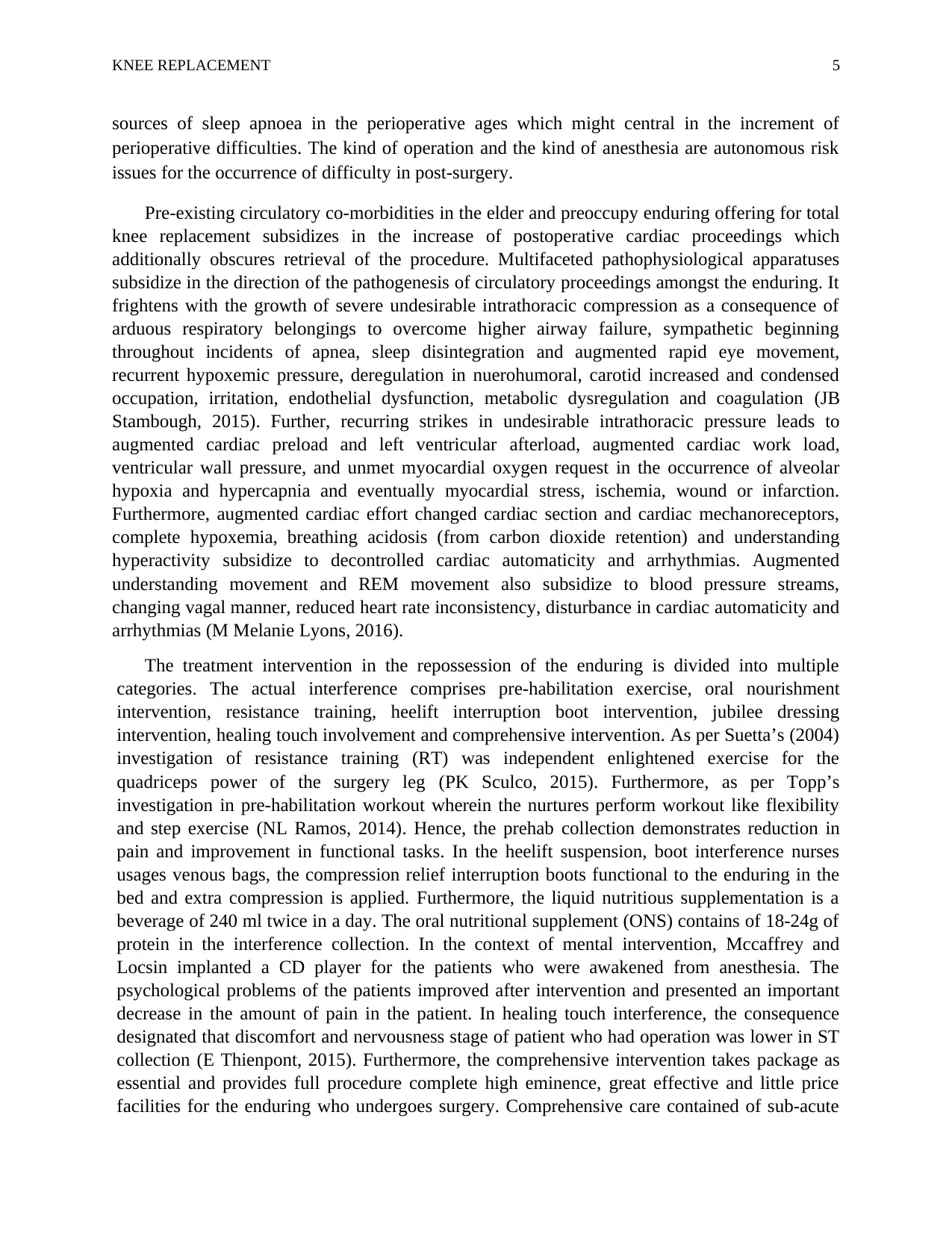
KNEE REPLACEMENT 5
sources of sleep apnoea in the perioperative ages which might central in the increment of
perioperative difficulties. The kind of operation and the kind of anesthesia are autonomous risk
issues for the occurrence of difficulty in post-surgery.
Pre-existing circulatory co-morbidities in the elder and preoccupy enduring offering for total
knee replacement subsidizes in the increase of postoperative cardiac proceedings which
additionally obscures retrieval of the procedure. Multifaceted pathophysiological apparatuses
subsidize in the direction of the pathogenesis of circulatory proceedings amongst the enduring. It
frightens with the growth of severe undesirable intrathoracic compression as a consequence of
arduous respiratory belongings to overcome higher airway failure, sympathetic beginning
throughout incidents of apnea, sleep disintegration and augmented rapid eye movement,
recurrent hypoxemic pressure, deregulation in nuerohumoral, carotid increased and condensed
occupation, irritation, endothelial dysfunction, metabolic dysregulation and coagulation (JB
Stambough, 2015). Further, recurring strikes in undesirable intrathoracic pressure leads to
augmented cardiac preload and left ventricular afterload, augmented cardiac work load,
ventricular wall pressure, and unmet myocardial oxygen request in the occurrence of alveolar
hypoxia and hypercapnia and eventually myocardial stress, ischemia, wound or infarction.
Furthermore, augmented cardiac effort changed cardiac section and cardiac mechanoreceptors,
complete hypoxemia, breathing acidosis (from carbon dioxide retention) and understanding
hyperactivity subsidize to decontrolled cardiac automaticity and arrhythmias. Augmented
understanding movement and REM movement also subsidize to blood pressure streams,
changing vagal manner, reduced heart rate inconsistency, disturbance in cardiac automaticity and
arrhythmias (M Melanie Lyons, 2016).
The treatment intervention in the repossession of the enduring is divided into multiple
categories. The actual interference comprises pre-habilitation exercise, oral nourishment
intervention, resistance training, heelift interruption boot intervention, jubilee dressing
intervention, healing touch involvement and comprehensive intervention. As per Suetta’s (2004)
investigation of resistance training (RT) was independent enlightened exercise for the
quadriceps power of the surgery leg (PK Sculco, 2015). Furthermore, as per Topp’s
investigation in pre-habilitation workout wherein the nurtures perform workout like flexibility
and step exercise (NL Ramos, 2014). Hence, the prehab collection demonstrates reduction in
pain and improvement in functional tasks. In the heelift suspension, boot interference nurses
usages venous bags, the compression relief interruption boots functional to the enduring in the
bed and extra compression is applied. Furthermore, the liquid nutritious supplementation is a
beverage of 240 ml twice in a day. The oral nutritional supplement (ONS) contains of 18-24g of
protein in the interference collection. In the context of mental intervention, Mccaffrey and
Locsin implanted a CD player for the patients who were awakened from anesthesia. The
psychological problems of the patients improved after intervention and presented an important
decrease in the amount of pain in the patient. In healing touch interference, the consequence
designated that discomfort and nervousness stage of patient who had operation was lower in ST
collection (E Thienpont, 2015). Furthermore, the comprehensive intervention takes package as
essential and provides full procedure complete high eminence, great effective and little price
facilities for the enduring who undergoes surgery. Comprehensive care contained of sub-acute
sources of sleep apnoea in the perioperative ages which might central in the increment of
perioperative difficulties. The kind of operation and the kind of anesthesia are autonomous risk
issues for the occurrence of difficulty in post-surgery.
Pre-existing circulatory co-morbidities in the elder and preoccupy enduring offering for total
knee replacement subsidizes in the increase of postoperative cardiac proceedings which
additionally obscures retrieval of the procedure. Multifaceted pathophysiological apparatuses
subsidize in the direction of the pathogenesis of circulatory proceedings amongst the enduring. It
frightens with the growth of severe undesirable intrathoracic compression as a consequence of
arduous respiratory belongings to overcome higher airway failure, sympathetic beginning
throughout incidents of apnea, sleep disintegration and augmented rapid eye movement,
recurrent hypoxemic pressure, deregulation in nuerohumoral, carotid increased and condensed
occupation, irritation, endothelial dysfunction, metabolic dysregulation and coagulation (JB
Stambough, 2015). Further, recurring strikes in undesirable intrathoracic pressure leads to
augmented cardiac preload and left ventricular afterload, augmented cardiac work load,
ventricular wall pressure, and unmet myocardial oxygen request in the occurrence of alveolar
hypoxia and hypercapnia and eventually myocardial stress, ischemia, wound or infarction.
Furthermore, augmented cardiac effort changed cardiac section and cardiac mechanoreceptors,
complete hypoxemia, breathing acidosis (from carbon dioxide retention) and understanding
hyperactivity subsidize to decontrolled cardiac automaticity and arrhythmias. Augmented
understanding movement and REM movement also subsidize to blood pressure streams,
changing vagal manner, reduced heart rate inconsistency, disturbance in cardiac automaticity and
arrhythmias (M Melanie Lyons, 2016).
The treatment intervention in the repossession of the enduring is divided into multiple
categories. The actual interference comprises pre-habilitation exercise, oral nourishment
intervention, resistance training, heelift interruption boot intervention, jubilee dressing
intervention, healing touch involvement and comprehensive intervention. As per Suetta’s (2004)
investigation of resistance training (RT) was independent enlightened exercise for the
quadriceps power of the surgery leg (PK Sculco, 2015). Furthermore, as per Topp’s
investigation in pre-habilitation workout wherein the nurtures perform workout like flexibility
and step exercise (NL Ramos, 2014). Hence, the prehab collection demonstrates reduction in
pain and improvement in functional tasks. In the heelift suspension, boot interference nurses
usages venous bags, the compression relief interruption boots functional to the enduring in the
bed and extra compression is applied. Furthermore, the liquid nutritious supplementation is a
beverage of 240 ml twice in a day. The oral nutritional supplement (ONS) contains of 18-24g of
protein in the interference collection. In the context of mental intervention, Mccaffrey and
Locsin implanted a CD player for the patients who were awakened from anesthesia. The
psychological problems of the patients improved after intervention and presented an important
decrease in the amount of pain in the patient. In healing touch interference, the consequence
designated that discomfort and nervousness stage of patient who had operation was lower in ST
collection (E Thienpont, 2015). Furthermore, the comprehensive intervention takes package as
essential and provides full procedure complete high eminence, great effective and little price
facilities for the enduring who undergoes surgery. Comprehensive care contained of sub-acute
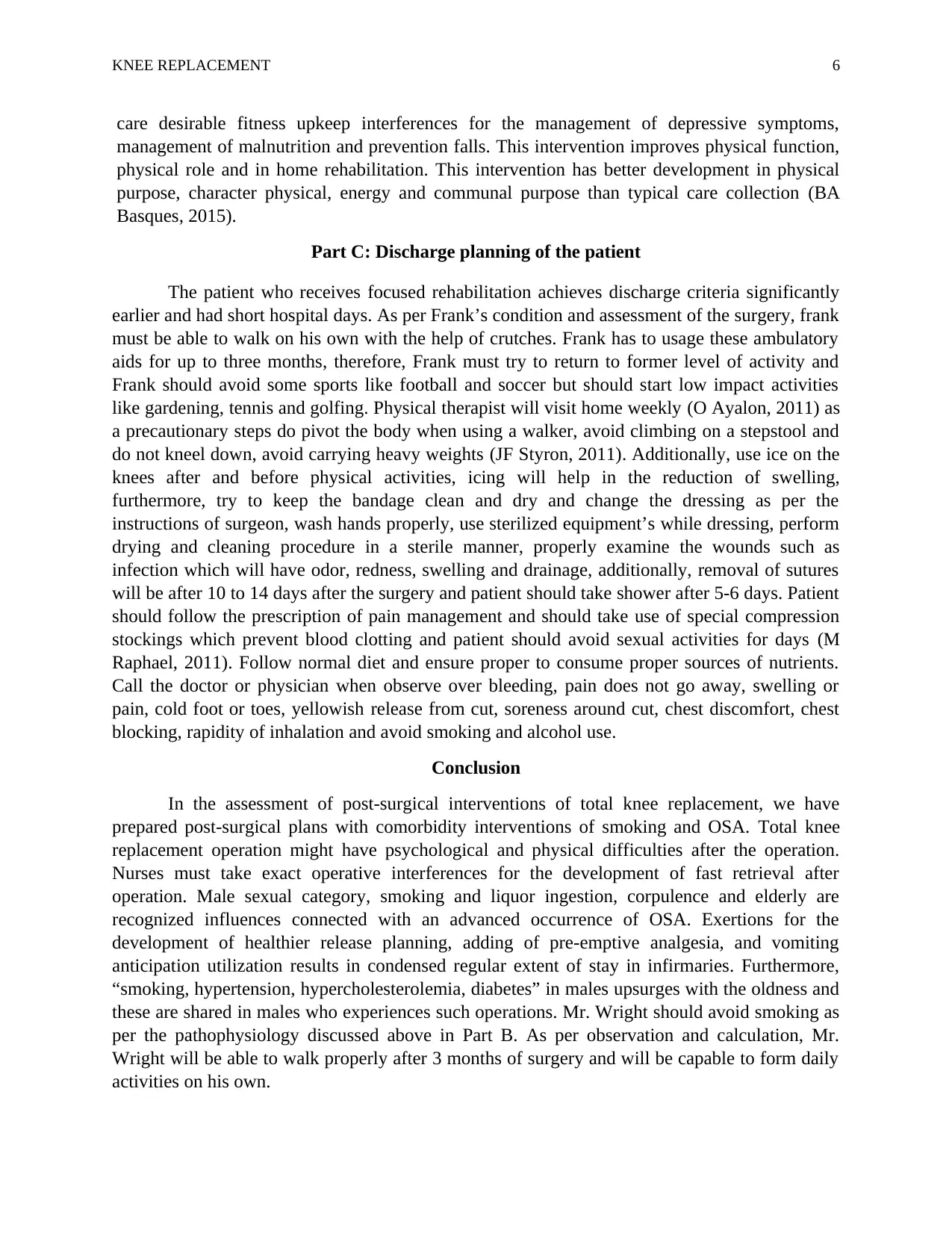
KNEE REPLACEMENT 6
care desirable fitness upkeep interferences for the management of depressive symptoms,
management of malnutrition and prevention falls. This intervention improves physical function,
physical role and in home rehabilitation. This intervention has better development in physical
purpose, character physical, energy and communal purpose than typical care collection (BA
Basques, 2015).
Part C: Discharge planning of the patient
The patient who receives focused rehabilitation achieves discharge criteria significantly
earlier and had short hospital days. As per Frank’s condition and assessment of the surgery, frank
must be able to walk on his own with the help of crutches. Frank has to usage these ambulatory
aids for up to three months, therefore, Frank must try to return to former level of activity and
Frank should avoid some sports like football and soccer but should start low impact activities
like gardening, tennis and golfing. Physical therapist will visit home weekly (O Ayalon, 2011) as
a precautionary steps do pivot the body when using a walker, avoid climbing on a stepstool and
do not kneel down, avoid carrying heavy weights (JF Styron, 2011). Additionally, use ice on the
knees after and before physical activities, icing will help in the reduction of swelling,
furthermore, try to keep the bandage clean and dry and change the dressing as per the
instructions of surgeon, wash hands properly, use sterilized equipment’s while dressing, perform
drying and cleaning procedure in a sterile manner, properly examine the wounds such as
infection which will have odor, redness, swelling and drainage, additionally, removal of sutures
will be after 10 to 14 days after the surgery and patient should take shower after 5-6 days. Patient
should follow the prescription of pain management and should take use of special compression
stockings which prevent blood clotting and patient should avoid sexual activities for days (M
Raphael, 2011). Follow normal diet and ensure proper to consume proper sources of nutrients.
Call the doctor or physician when observe over bleeding, pain does not go away, swelling or
pain, cold foot or toes, yellowish release from cut, soreness around cut, chest discomfort, chest
blocking, rapidity of inhalation and avoid smoking and alcohol use.
Conclusion
In the assessment of post-surgical interventions of total knee replacement, we have
prepared post-surgical plans with comorbidity interventions of smoking and OSA. Total knee
replacement operation might have psychological and physical difficulties after the operation.
Nurses must take exact operative interferences for the development of fast retrieval after
operation. Male sexual category, smoking and liquor ingestion, corpulence and elderly are
recognized influences connected with an advanced occurrence of OSA. Exertions for the
development of healthier release planning, adding of pre-emptive analgesia, and vomiting
anticipation utilization results in condensed regular extent of stay in infirmaries. Furthermore,
“smoking, hypertension, hypercholesterolemia, diabetes” in males upsurges with the oldness and
these are shared in males who experiences such operations. Mr. Wright should avoid smoking as
per the pathophysiology discussed above in Part B. As per observation and calculation, Mr.
Wright will be able to walk properly after 3 months of surgery and will be capable to form daily
activities on his own.
care desirable fitness upkeep interferences for the management of depressive symptoms,
management of malnutrition and prevention falls. This intervention improves physical function,
physical role and in home rehabilitation. This intervention has better development in physical
purpose, character physical, energy and communal purpose than typical care collection (BA
Basques, 2015).
Part C: Discharge planning of the patient
The patient who receives focused rehabilitation achieves discharge criteria significantly
earlier and had short hospital days. As per Frank’s condition and assessment of the surgery, frank
must be able to walk on his own with the help of crutches. Frank has to usage these ambulatory
aids for up to three months, therefore, Frank must try to return to former level of activity and
Frank should avoid some sports like football and soccer but should start low impact activities
like gardening, tennis and golfing. Physical therapist will visit home weekly (O Ayalon, 2011) as
a precautionary steps do pivot the body when using a walker, avoid climbing on a stepstool and
do not kneel down, avoid carrying heavy weights (JF Styron, 2011). Additionally, use ice on the
knees after and before physical activities, icing will help in the reduction of swelling,
furthermore, try to keep the bandage clean and dry and change the dressing as per the
instructions of surgeon, wash hands properly, use sterilized equipment’s while dressing, perform
drying and cleaning procedure in a sterile manner, properly examine the wounds such as
infection which will have odor, redness, swelling and drainage, additionally, removal of sutures
will be after 10 to 14 days after the surgery and patient should take shower after 5-6 days. Patient
should follow the prescription of pain management and should take use of special compression
stockings which prevent blood clotting and patient should avoid sexual activities for days (M
Raphael, 2011). Follow normal diet and ensure proper to consume proper sources of nutrients.
Call the doctor or physician when observe over bleeding, pain does not go away, swelling or
pain, cold foot or toes, yellowish release from cut, soreness around cut, chest discomfort, chest
blocking, rapidity of inhalation and avoid smoking and alcohol use.
Conclusion
In the assessment of post-surgical interventions of total knee replacement, we have
prepared post-surgical plans with comorbidity interventions of smoking and OSA. Total knee
replacement operation might have psychological and physical difficulties after the operation.
Nurses must take exact operative interferences for the development of fast retrieval after
operation. Male sexual category, smoking and liquor ingestion, corpulence and elderly are
recognized influences connected with an advanced occurrence of OSA. Exertions for the
development of healthier release planning, adding of pre-emptive analgesia, and vomiting
anticipation utilization results in condensed regular extent of stay in infirmaries. Furthermore,
“smoking, hypertension, hypercholesterolemia, diabetes” in males upsurges with the oldness and
these are shared in males who experiences such operations. Mr. Wright should avoid smoking as
per the pathophysiology discussed above in Part B. As per observation and calculation, Mr.
Wright will be able to walk properly after 3 months of surgery and will be capable to form daily
activities on his own.
⊘ This is a preview!⊘
Do you want full access?
Subscribe today to unlock all pages.

Trusted by 1+ million students worldwide

KNEE REPLACEMENT 7
Paraphrase This Document
Need a fresh take? Get an instant paraphrase of this document with our AI Paraphraser
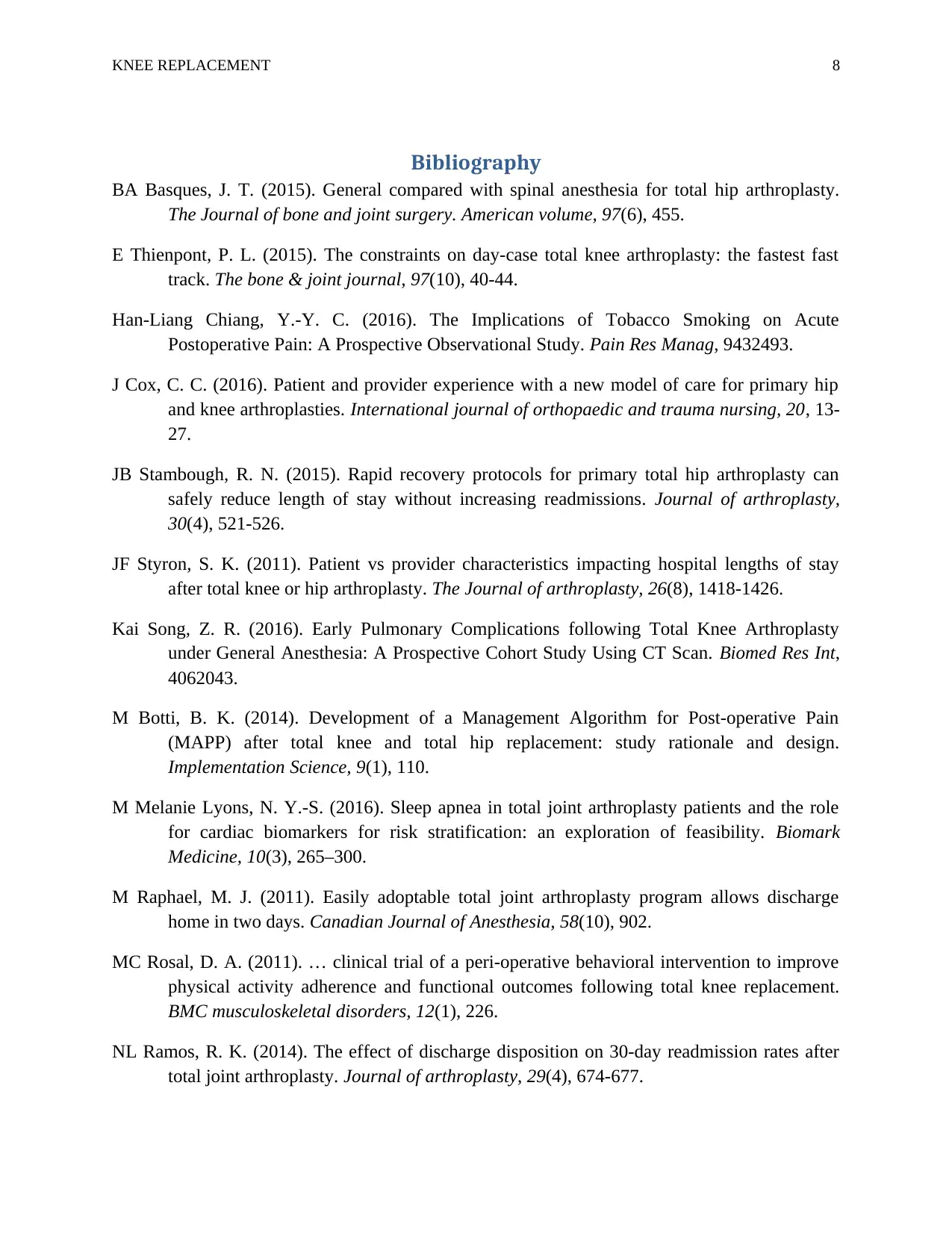
KNEE REPLACEMENT 8
Bibliography
BA Basques, J. T. (2015). General compared with spinal anesthesia for total hip arthroplasty.
The Journal of bone and joint surgery. American volume, 97(6), 455.
E Thienpont, P. L. (2015). The constraints on day-case total knee arthroplasty: the fastest fast
track. The bone & joint journal, 97(10), 40-44.
Han-Liang Chiang, Y.-Y. C. (2016). The Implications of Tobacco Smoking on Acute
Postoperative Pain: A Prospective Observational Study. Pain Res Manag, 9432493.
J Cox, C. C. (2016). Patient and provider experience with a new model of care for primary hip
and knee arthroplasties. International journal of orthopaedic and trauma nursing, 20, 13-
27.
JB Stambough, R. N. (2015). Rapid recovery protocols for primary total hip arthroplasty can
safely reduce length of stay without increasing readmissions. Journal of arthroplasty,
30(4), 521-526.
JF Styron, S. K. (2011). Patient vs provider characteristics impacting hospital lengths of stay
after total knee or hip arthroplasty. The Journal of arthroplasty, 26(8), 1418-1426.
Kai Song, Z. R. (2016). Early Pulmonary Complications following Total Knee Arthroplasty
under General Anesthesia: A Prospective Cohort Study Using CT Scan. Biomed Res Int,
4062043.
M Botti, B. K. (2014). Development of a Management Algorithm for Post-operative Pain
(MAPP) after total knee and total hip replacement: study rationale and design.
Implementation Science, 9(1), 110.
M Melanie Lyons, N. Y.-S. (2016). Sleep apnea in total joint arthroplasty patients and the role
for cardiac biomarkers for risk stratification: an exploration of feasibility. Biomark
Medicine, 10(3), 265–300.
M Raphael, M. J. (2011). Easily adoptable total joint arthroplasty program allows discharge
home in two days. Canadian Journal of Anesthesia, 58(10), 902.
MC Rosal, D. A. (2011). … clinical trial of a peri-operative behavioral intervention to improve
physical activity adherence and functional outcomes following total knee replacement.
BMC musculoskeletal disorders, 12(1), 226.
NL Ramos, R. K. (2014). The effect of discharge disposition on 30-day readmission rates after
total joint arthroplasty. Journal of arthroplasty, 29(4), 674-677.
Bibliography
BA Basques, J. T. (2015). General compared with spinal anesthesia for total hip arthroplasty.
The Journal of bone and joint surgery. American volume, 97(6), 455.
E Thienpont, P. L. (2015). The constraints on day-case total knee arthroplasty: the fastest fast
track. The bone & joint journal, 97(10), 40-44.
Han-Liang Chiang, Y.-Y. C. (2016). The Implications of Tobacco Smoking on Acute
Postoperative Pain: A Prospective Observational Study. Pain Res Manag, 9432493.
J Cox, C. C. (2016). Patient and provider experience with a new model of care for primary hip
and knee arthroplasties. International journal of orthopaedic and trauma nursing, 20, 13-
27.
JB Stambough, R. N. (2015). Rapid recovery protocols for primary total hip arthroplasty can
safely reduce length of stay without increasing readmissions. Journal of arthroplasty,
30(4), 521-526.
JF Styron, S. K. (2011). Patient vs provider characteristics impacting hospital lengths of stay
after total knee or hip arthroplasty. The Journal of arthroplasty, 26(8), 1418-1426.
Kai Song, Z. R. (2016). Early Pulmonary Complications following Total Knee Arthroplasty
under General Anesthesia: A Prospective Cohort Study Using CT Scan. Biomed Res Int,
4062043.
M Botti, B. K. (2014). Development of a Management Algorithm for Post-operative Pain
(MAPP) after total knee and total hip replacement: study rationale and design.
Implementation Science, 9(1), 110.
M Melanie Lyons, N. Y.-S. (2016). Sleep apnea in total joint arthroplasty patients and the role
for cardiac biomarkers for risk stratification: an exploration of feasibility. Biomark
Medicine, 10(3), 265–300.
M Raphael, M. J. (2011). Easily adoptable total joint arthroplasty program allows discharge
home in two days. Canadian Journal of Anesthesia, 58(10), 902.
MC Rosal, D. A. (2011). … clinical trial of a peri-operative behavioral intervention to improve
physical activity adherence and functional outcomes following total knee replacement.
BMC musculoskeletal disorders, 12(1), 226.
NL Ramos, R. K. (2014). The effect of discharge disposition on 30-day readmission rates after
total joint arthroplasty. Journal of arthroplasty, 29(4), 674-677.
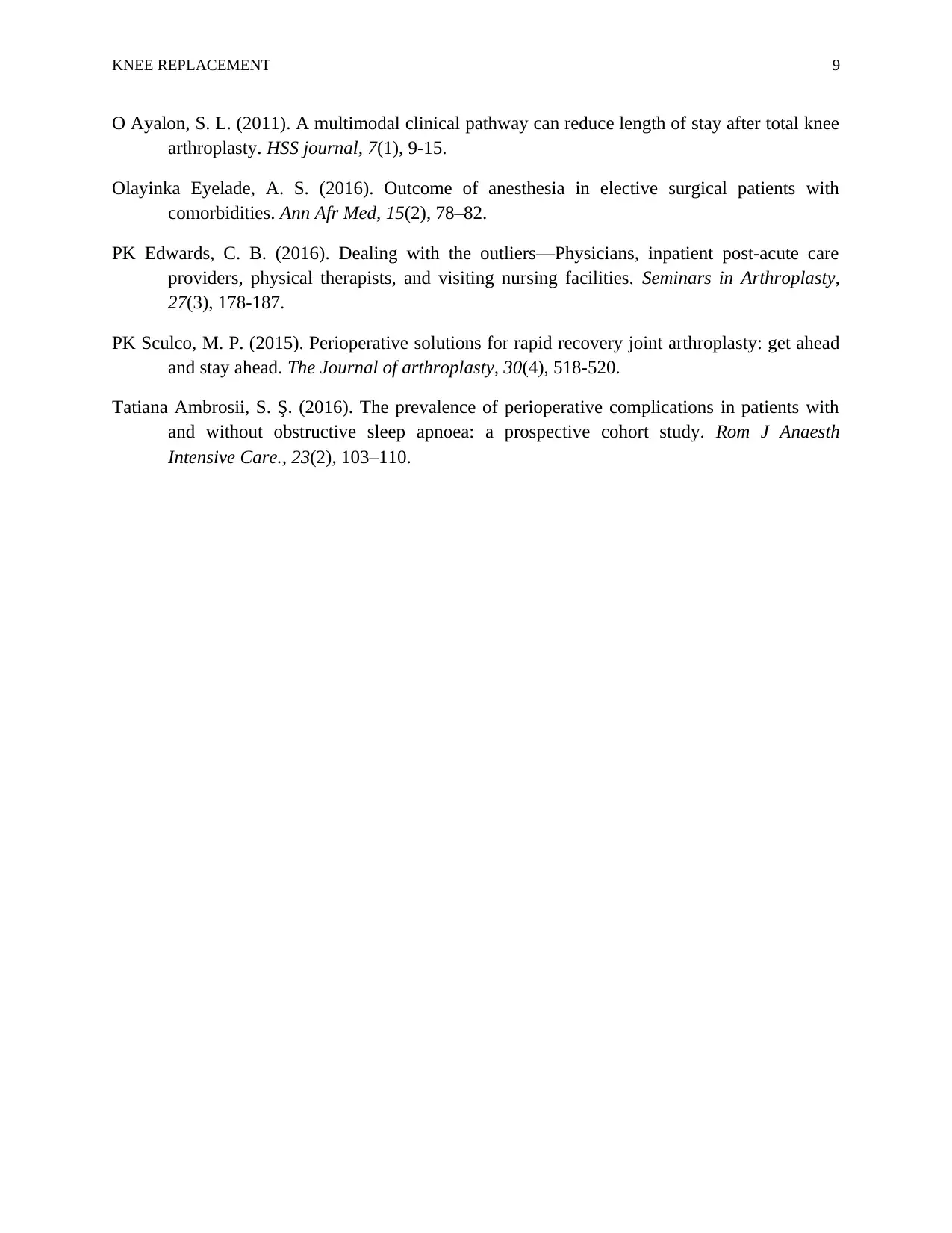
KNEE REPLACEMENT 9
O Ayalon, S. L. (2011). A multimodal clinical pathway can reduce length of stay after total knee
arthroplasty. HSS journal, 7(1), 9-15.
Olayinka Eyelade, A. S. (2016). Outcome of anesthesia in elective surgical patients with
comorbidities. Ann Afr Med, 15(2), 78–82.
PK Edwards, C. B. (2016). Dealing with the outliers—Physicians, inpatient post-acute care
providers, physical therapists, and visiting nursing facilities. Seminars in Arthroplasty,
27(3), 178-187.
PK Sculco, M. P. (2015). Perioperative solutions for rapid recovery joint arthroplasty: get ahead
and stay ahead. The Journal of arthroplasty, 30(4), 518-520.
Tatiana Ambrosii, S. Ş. (2016). The prevalence of perioperative complications in patients with
and without obstructive sleep apnoea: a prospective cohort study. Rom J Anaesth
Intensive Care., 23(2), 103–110.
O Ayalon, S. L. (2011). A multimodal clinical pathway can reduce length of stay after total knee
arthroplasty. HSS journal, 7(1), 9-15.
Olayinka Eyelade, A. S. (2016). Outcome of anesthesia in elective surgical patients with
comorbidities. Ann Afr Med, 15(2), 78–82.
PK Edwards, C. B. (2016). Dealing with the outliers—Physicians, inpatient post-acute care
providers, physical therapists, and visiting nursing facilities. Seminars in Arthroplasty,
27(3), 178-187.
PK Sculco, M. P. (2015). Perioperative solutions for rapid recovery joint arthroplasty: get ahead
and stay ahead. The Journal of arthroplasty, 30(4), 518-520.
Tatiana Ambrosii, S. Ş. (2016). The prevalence of perioperative complications in patients with
and without obstructive sleep apnoea: a prospective cohort study. Rom J Anaesth
Intensive Care., 23(2), 103–110.
⊘ This is a preview!⊘
Do you want full access?
Subscribe today to unlock all pages.

Trusted by 1+ million students worldwide

KNEE REPLACEMENT 10
1 out of 10
Related Documents
Your All-in-One AI-Powered Toolkit for Academic Success.
+13062052269
info@desklib.com
Available 24*7 on WhatsApp / Email
![[object Object]](/_next/static/media/star-bottom.7253800d.svg)
Unlock your academic potential
Copyright © 2020–2025 A2Z Services. All Rights Reserved. Developed and managed by ZUCOL.





